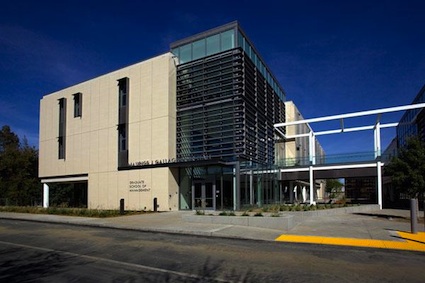U.C. Davis Earns Third LEED Platinum Award

DAVIS, Calif. — The University of California, Davis earned its third LEED Platinum certification from the U.S. Green Building Council for its new 83,000-square-foot complex.
The $34 million project includes the U.C. Davis Conference Center and the Maurice J. Gallagher Jr. Hall, home of the UC Davis Graduate School of Management. The complex was designed and built to use 30 percent less energy than a typical office building, according to a university statement.
The complex joins the U.C. Davis Robert Mondavi Institute for Wine and Food Science — the first brewery, winery and food-processing complex in the world to earn the Platinum designation — and the U.C. Davis Tahoe Environmental Research Center in Incline Village, Nev., which received LEED Platinum certification in 2007.
A $10 million gift from alumnus and Las Vegas airline executive Maurice J. Gallagher Jr. and his wife Marcia funded the Gallagher Hall project.
"We’re thrilled with the platinum rating for Gallagher Hall, which reflects the Graduate School of Management’s and UC Davis’ culture of environmental responsibility and our collective commitment to furthering the global adoption of sustainable green building and
development practices,” said Steven Currall, dean of the management school.
The certification makes Gallagher Hall the first LEED Platinum MBA school in the state and the third in the nation.
The Conference Center, which brings in nearly 500 conferences annually, hosted last year’s Governors’ Global Climate Summit 3, an event for leaders from around the world to develop sub-national collaboration on policies and strategies to reduce greenhouse gas pollution and stimulate green jobs.
The San Francisco office of Sasaki Associates Inc. designed the Graduate School of Management and Conference Center project, with Sundt Construction’s Sacramento, Calif., office as the general contractor.
In the fall of this year, the university also opened U.C. Davis West Village, a 130-acre zero net energy housing community. At build-out, the project will house 3,000 students, faculty and staff and be the largest zero net energy housing development in the country, according to the university.
Additional green measures at the university include its Smart Lighting Initiative, which aims to energy demand for lighting by 60 percent by 2015, and its Climate Action Plan, which enabled the campus to reduce greenhouse gas emissions to below year 2000 levels and targets year 1990 levels by 2020.
